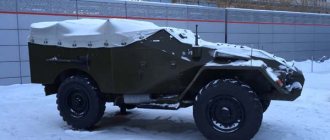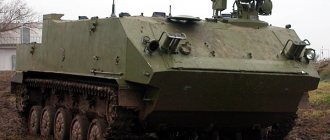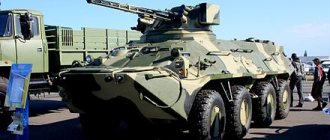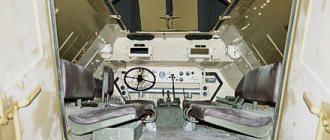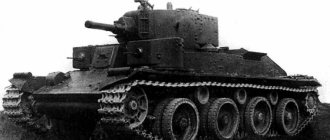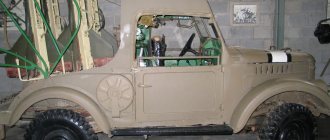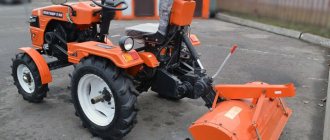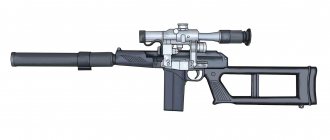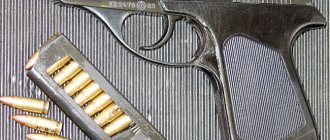Experienced armored personnel carrier K-78 (USSR)
In accordance with the technical specifications, by the summer of 1950, the Special Design Bureau under the Engineering Committee of the Soviet Army (OKB IK SA) developed the K-78 armored personnel carrier on the basis of the K-90 light amphibious tank. A design feature of this vehicle (as well as the tank) was the widespread use of components and assemblies of the M-2 tracked artillery tractor, YaAZ-200, M-20 and Moskvich vehicles. A prototype of the vehicle was manufactured at the Military Repair Plant No. 2 of the GBTU (Moscow) in May-June 1950. Specialists from the OKB IK SA under the leadership of A.F. Kravtsev in 1949-1950 worked on several versions of the new machine (under a single index), differing mainly in carrying capacity and capacity. The overall layout of armored personnel carriers remained largely unchanged. There was a version of a non-floating vehicle - K-78S (S - land), distinguished by the absence of water propulsion and the configuration of the rear part of the hull, made according to the model of the K-75 armored personnel carrier. On the basis of the armored personnel carrier, a project was also carried out for the K-78 amphibious self-propelled gun, equipped with an 85-mm anti-tank gun. However, an option was implemented in metal that was maximally unified with the K-90 amphibious tank. The K-78 armored personnel carrier was intended for crossing artillery, ammunition and infantry landings across water barriers. The crew consisted of two people - a driver and a vehicle commander.
The welded body of the armored personnel carrier consisted of five compartments: control, vehicle commander, engine, transmission and cargo (landing). The rigidity of the hull was ensured by two power frames, as well as five built-in torsion beams, rear power and transverse beams. The control compartment was located in the bow of the vehicle on the left side. It housed; driver's seat, levers and pedals of engine and transmission control drives, rudder control wheel, wave breaker control drive, instrumentation, inspection devices, part of spare parts, tank intercom apparatus, radio station, two periscope viewing devices PPN, borrowed from the tank T-54, two pins for mounting the SG-43 machine gun. There was a water drain valve under the driver's seat.
The vehicle commander's compartment was located on the left side of the hull behind the control compartment. It contained: the commander's seat, winch control levers, control for closing and opening the entrance blinds and the fan damper, a radio station, and a tank intercom apparatus. In the roof of the hull above the compartment there was a commander's hatch, closed with a hinged lid, as well as a TPK-1 periscope viewing device, providing all-round visibility. In front to the right of the commander's hatch on the roof and to the left of it on the side of the vehicle, sockets were installed for mounting the SG-43 machine gun. Behind the commander's hatch on board there was a socket for a removable PT-20 searchlight. The commander could control the searchlight from his squad. The engine compartment was located in the right front part of the armored personnel carrier's body and was separated from the control and commander compartments by a heat-insulating partition equipped with hatches. The following were installed in the engine compartment: a YaAZ-204B engine with an additional Multicyclone air filter, two fuel tanks, a fan and drives for it, a water radiator, a winch, and a nozzle heater (a device for heating the engine and starting it at low temperatures).
There was a hatch on the roof of the hull above the engine compartment, the lid of which had louvers for air intake. Exit louvers were located above the fan in the roof. The transmission compartment was located behind the engine compartment and the commander's compartment, under the cargo compartment. It contained: a YAZ-200 five-speed manual gearbox, a transfer (distribution) box, two propeller reverse boxes, final drives (two multi-disc dry friction onboard clutches), cardan shafts of the YAZ-200, M-20 vehicles, and the M-2 tractor. , two batteries, drives for controlling transmission units and propellers. The rotating parts of the transmission were covered with protective covers. A fan was installed on the cardan shaft connecting the transfer case and the main gear, which directed air from the main gear to the engine compartment through special air ducts. This ensured ventilation of the cargo compartment and cooling of the main gear.
In the rear of the K-78 there was a cargo (landing) compartment. It was separated from the engine compartment and the commander's compartment by a transverse partition (frame) of the hull. The cargo compartment contained removable hard seats for 22 landing troops, an intake pump and pipelines of the pumping system, two slots for a machine gun (one on each side), a box for spare parts, a tank intercom, a box with machine gun belts, hand grenades, accessories for fastenings for artillery systems, weapons spare parts and partially vehicle spare parts. To facilitate the landing and disembarkation of troops, loading and unloading of artillery systems and other military cargo, the rear side of the armored personnel carrier was made folding. Raising and lowering the side was carried out using a manual winch installed on the starboard side in the troop compartment (the hatch for access to the winch was located in the front wall of the cargo compartment).
On the platform of the cargo (landing) compartment the following could be installed: a 57-mm cannon with a transportable part of the ammunition and crew, an 85-mm cannon with part of the ammunition and the crew, or a 122-mm howitzer mod. 1938 with calculation (subject to absence of waves), as well as other cargo weighing up to 2.5 tons. Loading of artillery systems was carried out using a winch driven by the engine, along ramps with the tailgate folded down. In this case, two crossbars, used as rigid seats, were installed along the machine and used as cargo beams. On the outside of the cargo compartment, ramps were mounted and spare parts were partially placed. A towing device was attached under the folding side at the stern of the armored personnel carrier. The top of the cargo compartment was covered with a removable canvas awning.
The armor protection of the armored personnel carrier was bulletproof, made of rolled armor plates. The front sheets were made: the top one was made of 6 mm steel with an angle of 78; middle - made of 15 mm steel with an inclination angle of 40 and 35; side (chine) - made of 15 mm steel with an angle of 35. Side sheets: top - made of 10 mm steel with an angle of 30; the lower one (installed vertically) is made of 8 mm steel. Feed sheets: the bottom one is made of 6 mm steel with an angle of 45. The rear flap is made of 4 mm steel with an angle of 75, of 6 mm steel with an angle of 40, of 6 mm steel with an angle of 30. The roof was made of 6-mm steel with a slope of 68 and of 4-mm steel with a slope of 90. The folding armor flap made of 6-mm steel was without slope.
Suspension - individual, torsion bar. The K-78 prototype was equipped with a tracked propulsion unit using elements of the chassis of the M-2 tracked artillery tractor. It included tracks, idler wheels (interchangeable with support rollers) with tensioners, drive wheels located at the rear of the vehicle, and five support and three support rollers on each side (six- and seven-support versions of the vehicle were presented in the OKB IK SA projects ). The vehicle track was 2480 mm, the length of the supporting surface was 3250 mm. When turning, a minimum turning radius of 2960 mm was ensured. The movement of the K-78 on the water was carried out using two propellers with a pitch of 336 mm and a diameter of 600 mm, located in two aft tunnels. The minimum turning radius on water was: on two propellers using rudders - 15 m; on one right propeller or on one left propeller to the left - 50 m; the radius of circulation when turning with screws is 1.5 m. The design of the propulsors ensured that the armored personnel carrier exited the water onto the shore at angles of 20-25.
The electrical equipment was made according to a single-wire circuit. The on-board network voltage was 24 V. The main sources of electricity were two 6STE-140 batteries and a GSK-1500 generator with a power of 1.5 kW. K-78 was equipped with internal and external lighting devices with traffic alarms. A 10RT-26 radio station was installed for external communications, and a TPU-47 tank intercom for internal communications. The K-78 also had a mechanical pump for pumping water with a capacity of 250 l/min and a manual pump for pumping water with a capacity of 60 l/min.
Considering that the development of the K-78 was carried out according to a single technical specification and with the maximum degree of unification with the K-90 light amphibious tank, the question inevitably arises about comparing the technical level of the K-78 armored personnel carriers and the Object 750, created on the basis of the Object 740 amphibious tank. . From the presented characteristics it is clear that the carrying capacity of the K-78 on water (2500 kg) exceeded the carrying capacity of the BTR-50PA by 500 kg, and the maximum speed (45.9 km/h) was higher. The combat weight of the K-78 was 10.4 tons, which was 3.9 tons less than the combat weight of the BTR-50PA (14.3 tons). The fuel consumption of the K-78 was 6-40% less. In addition, the armored personnel carrier A.F. Kravtsev had significantly more compact dimensions and greater ground clearance. The positive features of the K-78 armored personnel carrier include the use in its design of components and assemblies that are well mastered by the automotive industry. The use of the engine of the mass-produced YaAZ-200 truck was also important. These circumstances predetermined significantly lower costs for operating and repairing the machine.
It is worth recalling that the armored personnel carrier, like the K-90 amphibious tank, was created by only one design team at the Military Repair Center and was developed at a powerful tank production facility with the involvement of five leading research organizations). At the same time, the machine created by OKB IK SA under the leadership of A.F. Kravtsev, complied with the customer’s specifications and, on the whole, successfully withstood intense tests. In accordance with Resolution of the Council of Ministers of the USSR No. 2486-983 dated June 10, 1950, the commission conducted, from May 19 to June 23, 1950, factory and field tests of a prototype of the K-78 amphibious tracked armored personnel carrier. The purpose of the tests was to determine the compliance of the tactical and technical characteristics of the prototype with the requirements, the reliability of the operation of all mechanisms, the ease of maintenance and repair of units in the field by the crew, the convenience of stowing troops and other military cargo, servicing the machine gun and sighting devices. During testing, the armored personnel carrier covered 2,037 km, of which: along dirt country roads - 1,523 km; on highways - 292 km; by water - 222 km. The engine worked for 157 hours, of which; without load - 11 hours, on water - 32 hours.
Run tests of the K-78 were carried out in the area of the NIIBT Test Site in the conditions of a dirt country road, broken by tanks, with a large number of undulating irregularities, as well as an asphalt and cobblestone highway. Moreover, these tests took place around the clock. Driving on the roads was carried out at the maximum possible speeds for the given road conditions. During testing, the K-78 armored personnel carrier was fully equipped with a transportable set of spare parts, filled with fuel and lubricants and additionally loaded with ballast to a combat weight of 10.4 tons.
The conclusion of the commission noted: 1. The prototype of the K-78 amphibious armored personnel carrier, according to the established indicators, complies with the tactical and technical requirements approved by Resolution of the Council of Ministers of the USSR No. 2486-983 of June 10, 1950. 2. The armored personnel carrier was created mainly on the basis of serial units and components of the M-2 artillery tractor, which greatly simplifies and reduces the cost of its production. 3. The K-78 amphibious armored personnel carrier ensures the crossing of infantry landing forces in the amount of 22-25 people or 57-85 mm artillery systems with crew and part of the ammunition over water obstacles and has the required reserve of buoyancy and sufficient stability. 4. The presented prototype of an armored personnel carrier has a number of design and manufacturing shortcomings that reduce its combat qualities. All detected deficiencies can be eliminated by making some design changes and improving workmanship. The main units and components that require modification are: - hull: - machine gun mount: - winch: - radiator: - wave guard: - suspension torsion shafts. Smoke in the troop compartment must also be eliminated and comfortable accommodation for the crew and troops must be ensured. 5. The commission considers it expedient to manufacture two experimental K-78 amphibious armored personnel carriers for state tests, provided that the deficiencies identified during testing of the first prototype are eliminated and domestic pump injectors are installed on the engine.
In total, two prototypes of the K-78 were produced in 1952. However, after factory tests were carried out, by decree of the USSR Council of Ministers of October 24, 1952, further work on armored personnel carriers was stopped. Today, a preserved example of the K-78 armored personnel carrier can be seen in the Military Historical Museum of Armored Weapons and Equipment (Kubinka village). In conclusion, it should be noted that in 1949-1950 (probably in the wake of interest in amphibious combat vehicles) in the OKB IK SV, headed by A.F. Kravtsev developed the K-91 heavy tank. However, it can be assumed that the failure that befell the K-90 and K-78 led to the cessation of all work on this vehicle.
Main tactical and technical characteristics of the K-78 armored personnel carrier Combat weight, tons - 10.4 Crew, people. — 2 + (19-22) Load capacity, kg: — on land 2000 — on water 2500 Overall dimensions, mm — 6760x2930x1800 Ground clearance (clearance), mm — 400 Reservation, mm — 15-6 Armament: — SP-43 machine gun ( 7.62 mm) — KPVT machine gun (14.5 mm) — rocket launcher (26 mm) Ammunition: — 14.5 mm cartridges / 7.62 mm cartridges, pcs. — 1000 — F-1 hand grenades, pcs. — 10 — signal cartridges (signal flares), pcs. - 24 Engine - Diesel YaAZ-204B, 2-stroke, 4-cylinder, liquid cooling, 142 hp. at 2100 rpm (with imported S-80 injectors) Specific power, hp/t 13.6 Specific ground pressure kg/cm - 0.53 Maximum speed, km/h: - on the highway - 45.9 — afloat forward/backward — 9.35/5 Buoyancy reserve in % — 35 Mooring thrust, t — 0.99 Cruising range, km: — on the highway 180-260 — afloat 60-70 Fuel reserve, l — 240 Obstacles to be overcome, m: - wall height - 0.7 - ditch width - 2.25 Fuel consumption per 100 km in liters: - on asphalt highways, dirt country roads - 64.2-122.0 - on water - 298, 0
The meaning of the word "armored personnel carrier"
In exceptional cases, if the enemy does not have anti-tank weapons, an armored personnel carrier can support rifle troops (infantry, infantry, airborne forces) with airborne weapon fire.
Previously - during the First World War and after - it was classified as a transport tank or transport tank.
According to the Soviet classification of 1933 “On the system of armored and tank weapons of the Red Army”, it was called an infantry transporter (on the chassis of a light tractor or tank).
The vehicles closest in class to an armored personnel carrier (in some countries there is no such division) are infantry fighting vehicles (IFVs) and airborne combat vehicles (AFVs). The difference lies in the tactical purpose and, as a consequence, the balance of combat and transport functions. The armored personnel carrier was mainly developed as an armed infantry vehicle, while the infantry fighting vehicles and infantry fighting vehicles were additionally assigned the task of directly supporting the infantry with cannon and machine gun fire in the offensive and defensive. Although many armored personnel carriers are equipped with fairly powerful large-caliber machine guns, the armament of these vehicles, as a rule, is not stabilized and has simplified sights, which limits its use mainly for self-defense purposes. BMPs and BMDs differ from armored personnel carriers in better security and greater firepower. The armored personnel carrier, having wheels, significantly exceeds them in the speed of movement on roads with improved surfaces. In turn, the BMD is distinguished by the ability of parachute airborne landing. An armored personnel carrier, compared to infantry fighting vehicles and infantry fighting vehicles, usually has several times lower production costs due to the lack of complex and high-tech combat equipment.
Recently, variants of tracked armored personnel carriers based on tanks with projectile armor have been developed. Thus, the differences between tracked armored personnel carriers, infantry fighting vehicles and infantry fighting vehicles in terms of their combat properties practically disappear. Externally, such an armored personnel carrier can be distinguished from an infantry fighting vehicle only by the main armament, which for an armored personnel carrier is usually a machine gun, while for an infantry fighting vehicle it is cannon or rocket-gun with a gun caliber of 20 mm or more. However, a number of heavy armored personnel carriers, such as the BTR-T, have weapons with a caliber of over 20 mm, which effectively blurs the line between armored personnel carriers and infantry fighting vehicles. Another less obvious difference is that infantry fighting vehicles and infantry fighting vehicles, unlike armored personnel carriers, are much more protected from the damaging effects of nuclear weapons.
For armored personnel carriers, unlike tanks and infantry fighting vehicles, the type of propulsion is not specified, so among armored personnel carriers there are both tracked and wheeled vehicles.
Colloquially referred to as armored carriers and armored personnel carriers.
BTR, BMP, BRM, BRDM, BMD
BTR-50P. Armored personnel carrier. (THE USSR)
BTR-50P is an armored personnel carrier based on the chassis of the PT-76 light amphibious tank. In-plant designation - Object 750.
The BTR-50P armored personnel carrier, adopted in 1954, had the same weapons as previous vehicles of this class. The crew of the armored vehicle had one 7.62-mm SGMB machine gun. After the modernization of the late sixties, all armored personnel carriers of this family were re-equipped with PKB machine guns. Both types of machine guns could be mounted on one of two brackets: on the front and rear plates of the troop compartment.
Devices for installing the SGMB machine gun were unified with units of armored personnel carriers of previous models. Thanks to this, the BTR-50P gunner could fire at fairly wide sectors in the front and rear hemispheres. The armored personnel carrier's machine gun used 250-round belts. The transportable ammunition included five belts - 1250 rounds.
BTR-50P. Armored personnel carrier. (THE USSR)
There are known attempts to install heavy-caliber DShKM and KPV machine guns on the BTR-50P armored personnel carrier. Despite the great firepower, such options for equipping armored vehicles did not become standard. It should be noted that there are photographs showing BTR-50P armored personnel carriers with large-caliber weapons, but such machine guns were installed only for parades.
Over time, the BTR-50P armored personnel carrier received an armored roof and a new designation - BTR-50PK. After such modernization, the armament of the armored personnel carrier remained the same, and large hatches were provided in the roof for its use.
According to some reports, the BTR-50P, like previous domestic armored personnel carriers, could become the basis for an anti-aircraft self-propelled gun. To do this, it was planned to mount a cabinet with a ZPTU-2 machine gun mount in the troop compartment. In addition, the option of using a four-barrel ZPTU-4 installation was considered. This technique did not go into production.
BTR-50P. Armored personnel carrier. (THE USSR)
Characteristics:
- Combat weight, t: 14.2;
- Layout: rear-engine;
- Crew, people: 2;
- Troops, people: 20;
- Case length, mm: 7070;
- Case width, mm: 3140;
- Height, mm: 2030;
- Ground clearance, mm: 270;
- Armor type: rolled homogeneous steel of high hardness; Body forehead, mm/deg. 10-13; Hull side, mm/deg. 8-10; Hull feed, mm/deg. 6;
- Machine guns: 1 × 7.62 mm SGMB machine gun (later PKMB);
- Engine power, l. p.: 240;
- Highway speed, km/h: 44.6;
- Cross-country speed, km/h: 10.2 (afloat);
- Cruising range on the highway, km: 380—420;
- Cruising range over rough terrain, km: 80—140 (afloat);
- Specific power, l. s./t: 16.7;
- Suspension type: individual torsion bar;
- Specific ground pressure, kg/cm²: 0.5;
- Climbability, degrees: 38°;
- Wall to be overcome, m: 1.1;
- Ditch to be overcome, m: 2.8;
- Fordability, m: floats.
BTR-50P. Armored personnel carrier. (THE USSR)
